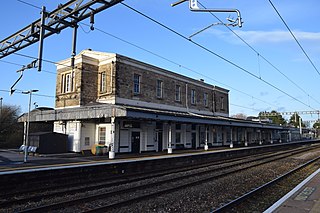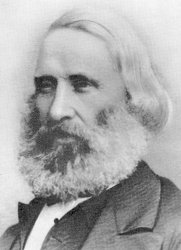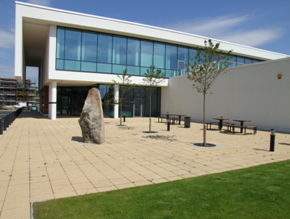
Swindon is a large town in Wiltshire, England. At the time of the 2021 Census the population of the built-up area was 183,638, making it the largest settlement in the county. Located in South West England, Swindon lies on the M4 corridor, 71 miles (114km) to the west of London and 36 miles to the east of Bristol. The Cotswolds lie just to the town's north and the North Wessex Downs to its south.

The Great Western Railway (GWR) was a British railway company that linked London with the southwest, west and West Midlands of England and most of Wales. It was founded in 1833, received its enabling Act of Parliament on 31 August 1835 and ran its first trains in 1838 with the initial route completed between London and Bristol in 1841. It was engineered by Isambard Kingdom Brunel, who chose a broad gauge of 7 ft —later slightly widened to 7 ft 1⁄4 in —but, from 1854, a series of amalgamations saw it also operate 4 ft 8+1⁄2 in standard-gauge trains; the last broad-gauge services were operated in 1892.

STEAM – Museum of the Great Western Railway, also known as Swindon Steam Railway Museum, is housed in part of the former railway works in Swindon, England – Wiltshire's 'railway town'. The 6,500-square-metre (70,000 sq ft) museum opened in 2000.

South Swindon is a constituency in the Borough of Swindon, Wiltshire, represented in the House of Commons of the UK Parliament since 2010 by Sir Robert Buckland, a Conservative, who previously served as Justice Secretary and Welsh Secretary.

The Great Western Railway (GWR) 6000 Class or King Class is a class of 4-6-0 steam locomotives designed for express passenger work and introduced in 1927. They were the largest locomotives built by the GWR, apart from the unique Pacific. The class was named after kings of the United Kingdom and of England, beginning with the then reigning monarch, King George V, and going back through history. They handled the principal GWR expresses on the main line from London to the West of England and on the Chiltern line to Birmingham and Wolverhampton, until 1962 when the class was withdrawn.

Swindon Works was opened by the Great Western Railway in 1843 in Swindon, Wiltshire, England. It served as the principal west England maintenance centre until closed in 1986.

Swindon railway station is on the Great Western Main Line in South West England, serving the town of Swindon, Wiltshire. The station is located 77 miles 23 chains west of London Paddington; it lies between Didcot Parkway and Chippenham. It is managed by Great Western Railway, which also operates all of the services from the station.

Chippenham railway station is on the Great Western Main Line (GWML) in South West England, serving the town of Chippenham, Wiltshire. It is 93 miles 76 chains down the line from the zero point at London Paddington and is situated between Swindon and Bath Spa on the GWML. The Wessex Main Line diverges from the GWML to the southwest of Chippenham and runs to Trowbridge via Melksham.

Joseph Armstrong was an English locomotive engineer and the second locomotive superintendent of the Great Western Railway. His younger brother George and one of his sons also became outstanding engineers in the employment of the GWR.

Swindon is a town in Wiltshire in the South West of England. People have lived in the town since the Bronze Age and the town's location, being approximately halfway between Bristol and London, made it an ideal location for the Locomotive Factories of the Great Western Railway in the 19th century.
The history of local government in Swindon has its origins in the Middle Ages. After a long period of very little change, there followed a new era, beginning in the 19th century, of constant redevelopment and re-adjustment.
Transport in Swindon, England, and the surroundings has directly contributed to the town's growth and the ingress of businesses and industries.

Arkell's Brewery was established in Swindon, England by John Arkell in 1843, and has been owned by members of the Arkell family since its establishment. It is Swindon's oldest company, built initially on the massive expansion of Swindon in the Victorian era with the arrival of the railways and the decision by Isambard Kingdom Brunel to site the Great Western Railway Works in Swindon in 1841.
The Swindon Civic Trust is a voluntary organisation and registered charity established in Swindon, England in 2001. Affiliated to the Civic Trust of England and Wales, the organisation's stated aims are to improve the quality of new and historic buildings and public spaces, and to help improve the general quality of urban life.

The Wiltshire and Swindon History Centre in Chippenham, Wiltshire, England, serves as a focal point for heritage services relating to Wiltshire and Swindon. The centre opened in 2007 and is funded by Wiltshire Council and Swindon Borough Council. It has purpose-built archive storage and research facilities and incorporates the local studies library, museums service, archaeology service, Wiltshire buildings record and the conservation service.

Steventon railway station was built when the Great Western Railway extended their main line from Reading to the village of Steventon, opening the line on 1 June 1840. Two months later, on 20 July, it was extended to Faringdon Road, and in December of that year, to Swindon.

Swindon Town railway station was on the Midland and South Western Junction Railway at Swindon in Wiltshire, England. The station was open from 1881 to 1972, and was sited in the Old Town area about one-and-a-half miles from the Great Western Railway's Swindon Junction.

Marlborough railway stations refers to the two railway stations which served Marlborough, Wiltshire, England, until 1964.

UTC Swindon is a University Technical College (UTC) in Swindon, England that opened in September 2014 for students of ages 14–19. The college specialises in engineering and is sponsored by Oxford Brookes University and Johnson Matthey Fuel Cells.

South Swindon is a civil parish in the town of Swindon, England. In 2021 it had a population of 62,871. South Swindon is the largest civil parish in the Borough of Swindon by population, and the sixth largest civil parish by population in England.

















